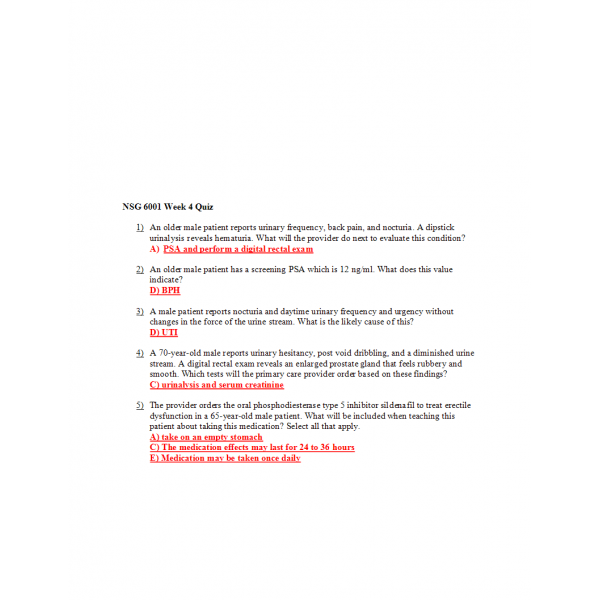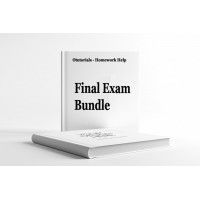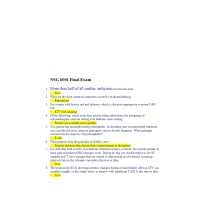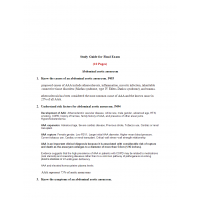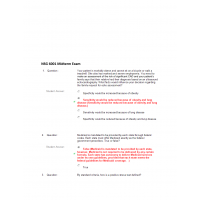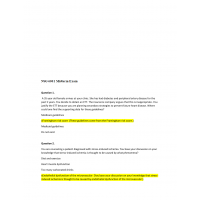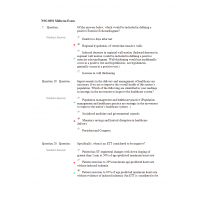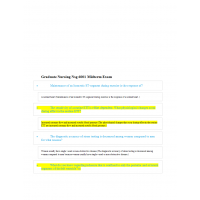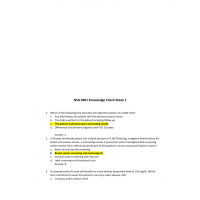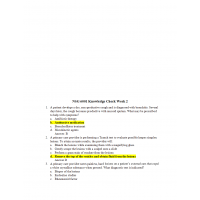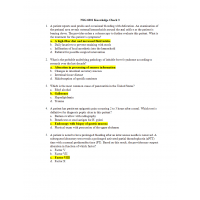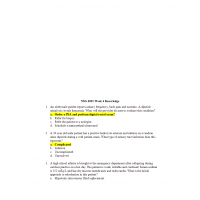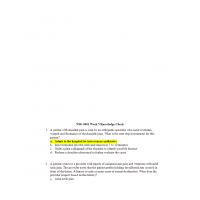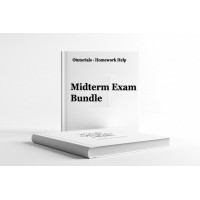NSG 6001 Week 4 Knowledge Check
An older male patient reports urinary frequency, back pain, and nocturia. A dipstick urinalysis reveals hematuria. What will the provider do next to evaluate this condition?
An older male patient has a screening PSA which is 12 ng/ml. What does this value indicate?
A male patient reports nocturia and daytime urinary frequency and urgency without changes in the force of the urine stream. What is the likely cause of this?
A 70-year-old male reports urinary hesitancy, post void dribbling, and a diminished urine stream. A digital rectal exam reveals an enlarged prostate gland that feels rubbery and smooth. Which tests will the primary care provider order based on these findings?
The provider orders the oral phosphodiesterase type 5 inhibitor sildenafil to treat erectile dysfunction in a 65-year-old male patient. What will be included when teaching this patient about taking this medication? Select all that apply.
Which is true about hypoactive sexual desire in older men?
A young adult male reports a dull pain in the scrotum and the provider notes a bluish color showing through the skin on the affected side. Palpation reveals a “bag of worms” on the proximal spermatic cord. What is an important next step in managing this patient?
An adolescent male reports severe pain in one testicle. The examiner notes edema and erythema of the scrotum on that side with a swollen, tender spermatic cord and absence of the cremasteric reflex. What is the most important intervention?
A high school athleteis brought to the emergency department after collapsing during outdoor practice on a hot day. The patient is weak, irritable, and confused. Serum Na is 152 mEq/ml and has dry mucous membranes and tachycardia. What is the initial approach for rehydration in this patient?
An elderly patient who is taking thiazide diuretic has been ill with nausea and vomiting and is brought into the emergency department for evaluation. An assessment reveals oliguria, hypotension, and tachycardia and serum sodium is 118 mEq/ml. What is the treatment.
Which thyroid stimulating hormone level indicates hyperthyroidism?
A patient has thyroid nodules and the provider suspects thyroid cancer. To evaluate thyroid nodules for potential malignancy, which test is performed?
What are some common goals of neuropsychiatric evaluation?
A patient exhibits visual field defect, ataxia, and dysarthria and complains of a mild headache. A family member reports that the symptoms began several hours prior. An examination reveals normal range of motion in the neck. What type of cerebrovascular event is most likely?
An elderly patient is brought to the emergency department after being found on the floor after a fall. The patient has unilateral sagging of the face, marked slurring of the speech, and paralysis on one side of the body. The patient’s blood pressure is 220/190 mm Hg. What is the likely treatment for this patient?
What are initial approaches when managing delirium in a hospitalized patient who is agitated and confused? (select all that apply)
A previously lucid patient with early-stage Alzheimer’s disease is hospitalized after a surgical procedure and exhibits distractibility and perceptual disturbances that occur only in the late afternoon.
An elderly patient has symptoms of depression and the patient’s daughter ask about possible Alzheimer’s disease since there is a family history this disease. A screening evaluation shows no memory loss. What is the itinal step in managing this patient?
A patient with dementia experiences agitation and visual hallucinations and is given haloperidol with subsequent worsening of symptoms. Based on this response what is the likely cause of the patient’s symptoms?
20) Which medication maybe useful in treating tension-type headache?
21). A patient has recurrent cluster headache and ask about abortive therapy. Which therapy is effect for the majority of patients with cluster headaches?
22). A patient with a seizure disorder has seizures which begin with eye twitching and occasionally visual hallucinations. Which site of the brain is the seizure focus?
23). A patient who has a seizure disorder and who takes levetiracetam is brought to an emergency department with a seizure which has persisted for 15 minutes and which immediately followed another 15-minute seizure. What is the priority action for this patient?
24). Which drug is used to treat patients with focal epilepsy?
25) Begin prostate hypertrophy is a common finding as men age. Classically, this condition has many symptoms.
26) A 63-year old presents to you with hematuria, hesitancy and dribbling. Digital rectal examination (DRE) reveals a moderately enlarged prostate that is smooth. The client’s prostate specific antigen (PSA) is 1.2. What is the most appropriate management strategy for the provider to follow at this time?
27) A 15-year-old client comes in with acute abdominal pain. When taking his history the nurse practitioner (NP) finds that he fell off his bike this morning and has vomited. Upon closer examination the NP determines his pain is localized to the left groin and testicle. He is afebrile and reports no dysuria. The most likely differential diagnosis is:
28) A client is pregnant and has been taking the same levothyroxine medication for years. What might the provider expect to do with the levothyroxine medication?
29) A TSH of 0.2 can lead to the following symptoms.
30) Which of the following are causes of dementia in older adults that can be removed or reversed?
| Institution & Term/Date | |
| Term/Date | South University |
NSG 6001 Week 4 Knowledge Check 2
- Product Code: 2019
- Availability: In Stock
-
$22.00
Related Products
NSG 6001 Final Exam 1
$45.00
NSG 6001 Midterm Exam 1
$25.00
NSG 6001 Midterm Exam 2
$25.00
NSG 6001 Midterm Exam 3
$15.00
NSG 6001 Midterm Exam Review
$25.00

